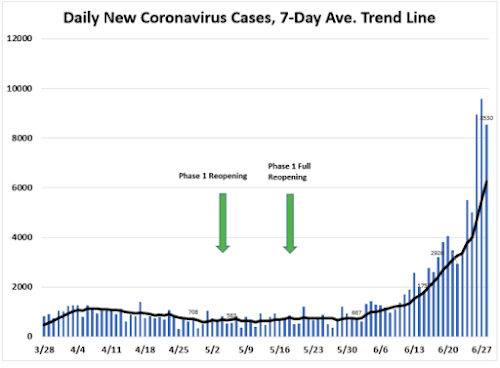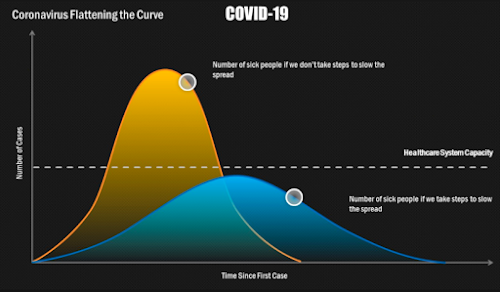The states that seem to be most prominently mentioned are Arizona, Florida and Texas.
However, cases have been rising in states such as California, Oregon, Idaho, Montana, Wyoming, Georgia, South Carolina and Oklahoma as well.
What are we to make of this?
The popular narrative is that this is due to these states opening up too soon.
Is this accurate?
Let's look at some data.
First, I thought that this heat map prepared by @kylamb8 was interesting in showing the counties with the highest increase in Covid-19 cases for the 21-day period ending June 23. Counties in red are experiencing the highest case growth compared to the national averages.
Notice the large increase in cases in the Sunbelt and and near the Mexican border.
Mexico has seen a massive increase in cases.
Is it a coincidence that a number of the hot spots are close to the Mexican border or who have a lot of migrants living there?
Look at the numbers at border counties compared to other counties in Arizona and California.
Another interesting fact I recently came across is that CDC data indicates that Hispanics make up 43% of all cases of Covid-19 between the ages of 18 and 50. This is the chart for ages 30-39 but a similar distribution is shown for ages 18-29 and 40-49. Hispanics are about 18% of the overall USA population.
 |
| Source: CDC |
This chart shows what is happening in Mexico. It had a 49.4% positivity rate on tests yesterday.
These numbers are also probably vastly understated as Mexico is doing very little testing. The United States is conducting 22 times the number of tests as Mexico is per thousand people.
You can also see from this chart that there is no country that comes close to the United States in the number of tests . This undoubtedly is partly responsible for the higher number of confirmed cases.
What is interesting, but is largely being ignored by the media, is that while the cases are increasing across the country at large the death rate from Covid-19 continues to fall.
These charts from The New York Times tell the story in one image.
New cases and the 7-day average are hitting new highs.
However, the 7-day average in deaths is the lowest it has been since March 31.
Why is this?
Is the virus weakening?
Are we do do a better job in treating Covid-19?
Is this due to the fact that infections now are occurring in younger demographics?
New cases over most of the country are coming from younger age groups. A lot these are also now being picked up because of increased testing.
For example, in Florida the median age of confirmed cases has dropped from age 65 in April to around age 40. New cases over the last several weeks are seeing a median age of between 33-35.
Here is the most recent distribution of cases in Florida by age group.
 |
| Source: Florida Department of Health, 6/28/20 |
Let's take a closer look at the Florida numbers as I think it is instructive as to what is happening in some of the other hot spot states right now.
Cases are up substantially.
 |
| Source: https://tallahasseereports.com/2020/06/27/two-charts-show-positive-trends-for-florida-in-coronavirus-battle/ |
However, hospitalizations are at about the same level as in April.
 |
| Source: https://tallahasseereports.com/2020/06/27/two-charts-show-positive-trends-for-florida-in-coronavirus-battle/ |
Deaths are also down from their peaks and have been remarkably stable over the last month
 |
| Source: https://tallahasseereports.com/2020/06/27/two-charts-show-positive-trends-for-florida-in-coronavirus-battle/ |
Governor Ron DeSantis recently acknowledged that Florida is seeing more confirmed cases but that the younger age group it is coming from means far less acute cases that are putting less pressure on the health infrastructure in the state.
"If you had a thousand cases under the age of 30," he said, "that would have (less) clinical significance than if you had 15 cases among residents of a long-term care facility."
It is probably no coincidence that the mainstream media is putting all of the focus on cases but is not reporting much on the trends in hospitalizations and deaths.
The media has seemed to be particularly interested in any negative reports coming from Florida since DeSantis was slow to lockdown his state as well as earlier in opening it up.
The Governors of New York, New Jersey and Connecticut recently announced that they were going to quarantine anyone from Florida and other so-called "hot spots" to quarantine for 14 days if entering New York.
However, have you seen anyone report that New York and New Jersey are still reporting more deaths from Covid-19 in recent days than we are seeing in Florida?
For example, here are the total deaths reported for the three states over the last two days (June 26 and 27) according to the New York Times Covid-19 database.
Florida 63
New Jersey 76
New York 76
This chart suggests that Florida has a long way to go before it gets anywhere close to New Jersey let alone New York which actually has worse numbers.
Has the reopening contributed to the new cases in Florida and elsewhere?
There has to be some correlation but it was well over a month from the reopenings in Florida before there was any appreciable increase in cases (see Florida chart above). That is a long time considering a virus that has a 5-day average incubation period. Why didn't the cases increase earlier?
Let's look at Texas which is another state that the media likes to highlight.
Cases were actually trending down in the last two weeks of May even though the state started opening up on May 1. If the reopenings are responsible for the increase in cases why didn't those increases start in May?
What happened near the end of May that could have had an effect?
Memorial Day gatherings?
A whole bunch of street protests?
Look at the increase in cases in Houston, Texas (Harris County) over the last two weeks.
The 7-day average has increased from 313 to 1,184 per day over the last 14 days.
Could these events have something to do with those numbers?
 |
| March for George Floyd, June 2, 2020 |
 |
| George Floyd funeral in Houston, June 9, 2020 |
These events very well could have had an effect on the cases we are seeing now but you don't see anyone suggesting that.
It also could be the heavy ties that Houston has to the Mexican community.
Finally, I am also wondering if the beginning of summer has driven more people indoors in seek of air conditioning and this has contributed to the rise of cases across the Sunbelt.
It is curious that cases have generally decreased in the Northeast and Midwest as more people left their homes and got more outside air and sun but cases have increased in the Sunbelt as rising heat levels has caused more people stay indoors.
What do I make of all of this? Is there cause for alarm with the increased cases?
I generally see all of this as part of the original arguments we heard about flattening the curve.
We were told that we had to flatten the curve. If we did not do that our hospitals would be overwhelmed and hundreds of thousands might die due to lack of care.
Flattening the curve does not mean any fewer people will get the virus. It just spreads out the time period over which people get infected. It also does not decrease the numbers who will naturally die from the virus. It primarily only prevents those who would die who could have otherwise been saved with hospital intervention if those resources were not overwhelmed.
An additional benefit of flattening the curve is that it does provide time for the development of better treatment protocols and care standards as we learn more about the virus as well as buying time for the possible development of a vaccine.
The areas under the yellow curve and blue curve (representing the number of cases) are the same.
If that is the case it can certainly be argued that what we are seeing right now is exactly a result of flattening the curve.
Cases that we might have seen in March and April have been pushed into June due to the economic lockdowns. Some of this was expected. What was not expected was that thousands would be taking to the streets as well without considering any social distancing protocols.
There also seems to be a natural point at which the virus starts to die out. Nothing goes on forever. Most of the states that had high case loads early have now died down. Most of the states with high case loads today had relatively few cases earlier.
There is natural cycle in play here that has been seen worldwide.
Here are the charts on a number of major countries that shows the rise and fall of virus cases in these nations.
 |
| Source: https://www.endcoronavirus.org/countries |
These are remarkably similar with the exception of China in which no one is sure we can trust their numbers.
Some have stated they believe this is the case because the virus appears to have difficult in spreading once it reaches 15-20% prevalence in a community. This is because it is believed that a substantial number already have some type of immunity due to past exposure to "common cold" coronaviruses. This might be as high as 70%-80%.
Many of these countries would also be similar to the size of the various states (based on both population and geographic size) in the United States. These states could almost be viewed as similar to various countries in Europe.
Look at the charts for some of the states that had the worst case experience a month or two ago and have now improved. They look very similar to the countries above.
Compare those charts to some of the states that we are now seeing increasing cases. Is it just their turn? Is it necessary for them to get to the 15-20% level before these curves turn down in these states as well?
Seeing the age distribution of the cases, the fairly flat hospitalization rates and the declining mortality rates, I am more optimistic than pessimistic about where we are in navigating the curve right now.
We will learn more as we navigate the curve some more.
However, despite what the media is trying to sell. I do not see undue cause for concern right now considering everything I am seeing in the new "hot spot" states.
This just seems to be the way we have to navigate the curve.
The nature of any curve is that you come around a turn at some point. There is a turn ahead in the new hot spot states as well. The cases we are seeing now suggests that it is approaching more rapidly than it might have otherwise due to what is happening in Mexico and what has happened on our streets over the last month.
Stay informed. Stay strong. Stay safe.












Nice summary of data and sources. I've heard doctors say that Texas and other places closed "too soon" and that now we are having the peak that seems to happen for this to run its course. Obviously the shutdown was a huge blow to the economy, but we didn't overwhelm the hospitals in Texas, and maybe bought some time to learn how to better deal with the disease and to not overwhelm our hospitals. One thing is for sure, NO ONE is considering the long-term effects of the economic impacts. WE SHOULD HAVE TAKEN SWEDEN'S PATH.
ReplyDelete